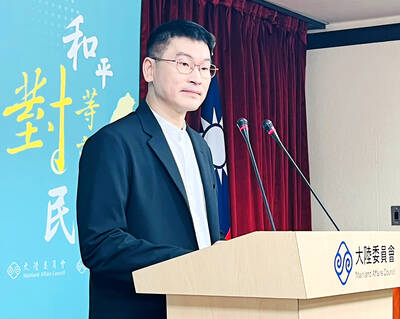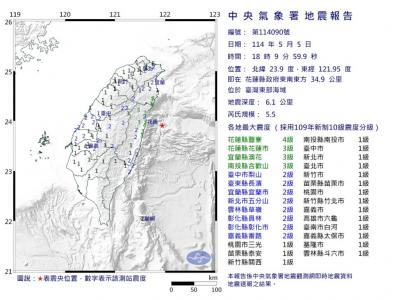A major new analysis concludes that China’s military modernization program has focused on building capabilities to coerce Taiwan into unification.
The analysis also says the program is aimed at establishing air supremacy over Taiwan and interdicting and destroying US surface ships entering the region.
Written by Dan Blumenthal, director of Asian studies at the American Enterprise Institute and published by the National Bureau of Asian Research, the analysis says that Chinese operational planning for Taiwan seems to include a punitive attack on the nation.
Blumenthal, a former senior director for China and Taiwan at the Pentagon’s Office of International Security Affairs, argues that China’s strategy would be guided by the principles of surprise, possible pre-emption and “decisive blows.”
This strategy is driven, he says, by lessons that China believes that it has learned from Iraq’s failed strategy and tactics during the first Gulf War.
“According to Chinese analysts, in that conflict the United States was given too much time to build up its forces without being attacked and Iraqi Scud missiles were not fired in a concentrated and operationally effective manner,” Blumenthal said
The 30-page analysis says: “If China does not achieve its desired strategic goals with a quick punitive strike against Taiwan — by, for example, bringing Taiwan to the table on Beijing’s terms — it appears to have plans in place to escalate the conflict. The [People’s Republic of China (PRC)] could utilize missile forces to kick in the door on the island by taking out all Taiwan’s airfields and runways and establishing air superiority over the Strait. China’s increasingly sophisticated air force could then attack Taiwan with relative impunity.”
At the same time, Blumenthal says, China might seek to “strike devastating blows against the United States and Japan” in order to keep the two countries from intervening.
“Indeed, China is contemplating massive air and missile strikes on the Kadena and Iwakuni air bases in Japan, despite the geopolitical risks. Beijing may be willing to take this risk if it calculates that a devastating blow against the US and allied bases would present Washington with a fait accompli because the US has no good conventional responses and would not risk nuclear escalation,” he added.
If China decides it needs to engage US forces to win in Taiwan, the analysis argues, the People’s Liberation Army (PLA) would execute a sea-denial strategy employing attack submarines, fighter aircraft equipped with cruise missiles and land-based ballistic missiles with maneuverable warheads to threaten US aircraft carriers.
“When dealing with a political issue for which China has raised the stakes to a very high level, such as Taiwan, the PRC may be willing to use a great deal of force and attain a high level of doctrinal and technical innovation to achieve its goals. That the United States has nuclear-powered carriers, F-22s or Virginia-class submarines does not matter if Washington chooses not to use such assets within China’s close-in kill zones. The key questions are what would we actually bring to the fight and when and how would we do so?” he asked.
The analysis also asks under what conditions would US allies — Japan, Singapore and Australia — fight alongside each other and the US?
Japan, says the analysis, may be eager to clear its territorial waters of PLA surface ships and submarines, but “responding to an attack on Taiwan, particularly if Japan itself is not attacked, may be a whole other matter.”
Blumenthal says that if China conducts an unprovoked attack that looks like an opening gambit to change the regional balance of power, then perhaps Canberra, Singapore and Tokyo “would do what they could to help defeat PRC forces.”
However, he added: “Today, it is just as easy to imagine that they would be reluctant to participate.”

An essay competition jointly organized by a local writing society and a publisher affiliated with the Chinese Communist Party (CCP) might have contravened the Act Governing Relations Between the People of the Taiwan Area and the Mainland Area (臺灣地區與大陸地區人民關係條例), the Mainland Affairs Council (MAC) said on Thursday. “In this case, the partner organization is clearly an agency under the CCP’s Fujian Provincial Committee,” MAC Deputy Minister and spokesperson Liang Wen-chieh (梁文傑) said at a news briefing in Taipei. “It also involves bringing Taiwanese students to China with all-expenses-paid arrangements to attend award ceremonies and camps,” Liang said. Those two “characteristics” are typically sufficient

A magnitude 5.9 earthquake that struck about 33km off the coast of Hualien City was the "main shock" in a series of quakes in the area, with aftershocks expected over the next three days, the Central Weather Administration (CWA) said yesterday. Prior to the magnitude 5.9 quake shaking most of Taiwan at 6:53pm yesterday, six other earthquakes stronger than a magnitude of 4, starting with a magnitude 5.5 quake at 6:09pm, occurred in the area. CWA Seismological Center Director Wu Chien-fu (吳健富) confirmed that the quakes were all part of the same series and that the magnitude 5.5 temblor was

The brilliant blue waters, thick foliage and bucolic atmosphere on this seemingly idyllic archipelago deep in the Pacific Ocean belie the key role it now plays in a titanic geopolitical struggle. Palau is again on the front line as China, and the US and its allies prepare their forces in an intensifying contest for control over the Asia-Pacific region. The democratic nation of just 17,000 people hosts US-controlled airstrips and soon-to-be-completed radar installations that the US military describes as “critical” to monitoring vast swathes of water and airspace. It is also a key piece of the second island chain, a string of

The Central Weather Administration has issued a heat alert for southeastern Taiwan, warning of temperatures as high as 36°C today, while alerting some coastal areas of strong winds later in the day. Kaohsiung’s Neimen District (內門) and Pingtung County’s Neipu Township (內埔) are under an orange heat alert, which warns of temperatures as high as 36°C for three consecutive days, the CWA said, citing southwest winds. The heat would also extend to Tainan’s Nansi (楠西) and Yujing (玉井) districts, as well as Pingtung’s Gaoshu (高樹), Yanpu (鹽埔) and Majia (瑪家) townships, it said, forecasting highs of up to 36°C in those areas